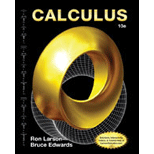
Vertical Motion In Exercises 95 and 96, use the position function
A silver dollar is dropped from the top of a building that is1362 feet tall.
(a) Determine the position and velocity functions for the coin.
(b) Determine the average velocity on the interval [1, 2].
(c) Find the instantaneous velocities when
(d) Find the time required for the coin to reach ground level.
(e) Find the velocity of the coin at impact.
Trending nowThis is a popular solution!

Chapter 2 Solutions
Bundle: Calculus, 10th + WebAssign Printed Access Card for Larson/Edwards' Calculus, 10th Edition, Multi-Term
- 4.1 Basic Rules of Differentiation. 1. Find the derivative of each function. Write answers with positive exponents. Label your derivatives with appropriate derivative notation. a) y=8x-5x3 4 X b) y=-50 √x+11x -5 c) p(x)=-10x²+6x3³arrow_forwardPlease refer belowarrow_forwardFor the following function f and real number a, a. find the slope of the tangent line mtan = f' (a), and b. find the equation of the tangent line to f at x = a. f(x)= 2 = a = 2 x2 a. Slope: b. Equation of tangent line: yarrow_forward
- (1) (16 points) Let f(x, y) = 2x + 3y + In(xy) (a) (6 points) Calculate the gradient field Vf(x, y) and determine all points (x, y) where ▼f(x, y) = (0, 0). (b) (4 points) Calculate the second derivative matrix D²f(x,y).arrow_forwardLet f(x, y) = 2x + 3y+ In(xy)arrow_forward(3) (16 points) Let D = [0, π/2] × [0, 7/6]. Define T: DCR2 R3 by → T(0, 4) = (2 sin cos 0, 2 sin sin 0, 2 cos x). Let S be the surface parametrized by T. (a) (8 points) Determine the normal, call it n(p), for the tangent plane TS at an arbitrary point p = T(0, 4). (b) (4 points) Show that n(p) parallel to the position vector T(0, 4) determined by p? Do the two vectors have the same direction or opposite direction? Explain. (c) (4 points) At which points p, if any, is TS parallel to the xy-plane?arrow_forward
- Algebra & Trigonometry with Analytic GeometryAlgebraISBN:9781133382119Author:SwokowskiPublisher:Cengage
 Functions and Change: A Modeling Approach to Coll...AlgebraISBN:9781337111348Author:Bruce Crauder, Benny Evans, Alan NoellPublisher:Cengage Learning
Functions and Change: A Modeling Approach to Coll...AlgebraISBN:9781337111348Author:Bruce Crauder, Benny Evans, Alan NoellPublisher:Cengage Learning Trigonometry (MindTap Course List)TrigonometryISBN:9781337278461Author:Ron LarsonPublisher:Cengage Learning
Trigonometry (MindTap Course List)TrigonometryISBN:9781337278461Author:Ron LarsonPublisher:Cengage Learning


